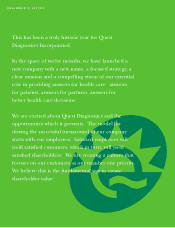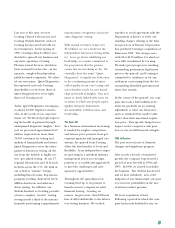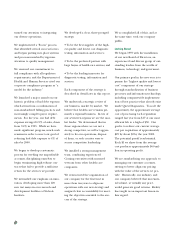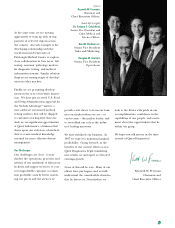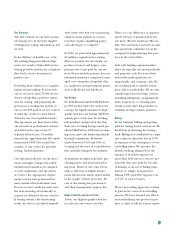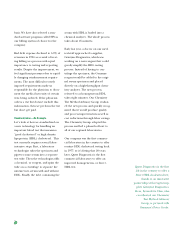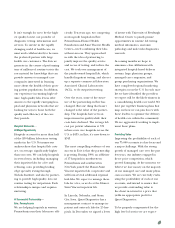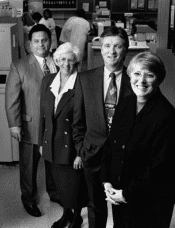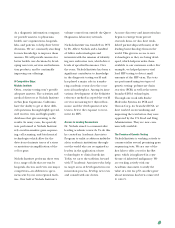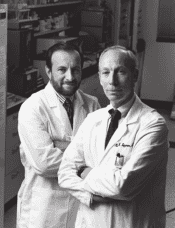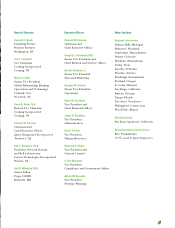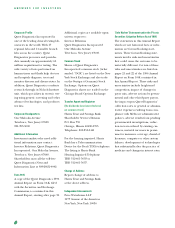Quest Diagnostics 1996 Annual Report Download - page 11
Download and view the complete annual report
Please find page 11 of the 1996 Quest Diagnostics annual report below. You can navigate through the pages in the report by either clicking on the pages listed below, or by using the keyword search tool below to find specific information within the annual report.
10
ciently. Ten years ago, two competing
not-for-profit hospitals in Erie,
Pennsylvania--Hamot Health
Foundation and Saint Vincent Health
Center—tried combining their labs,
without success. They approached
us with the idea of partnering to
jointly improve the quality, service
and access of testing, and reduce the
cost. We took over management of
the jointly-owned hospital lab, which
handled inpatient testing, and also set
up a separate commercial laboratory,
Associated Clinical Laboratories
(ACL), to do outpatient testing.
Over the years, some of the struct-
ure of the partnership in Erie has
changed. But one thing that hasn’t
changed is the value of the partner-
ship. The hospitals have seen an
improvement in quality while their
costs have declined. The average lab
cost per patient admission at 571
urban acute care hospitals across the
U.S. is $435; in Erie, it’s now down to
$343.
The most compelling evidence of our
success in Erie is that the partnership
is growing. During 1996, an addition-
al 17 hospitals in northwestern
Pennsylvania and southwestern
New York joined the Hamot-Saint
Vincent inpatient lab cooperative and
will form several additional regional
hub labs. We expect to manage these
labs for a fee, as we do at the Hamot-
Saint Vincent inpatient lab.
In Lincoln, Nebraska, and Sioux
City, Iowa, Quest Diagnostics has a
management contract to manage in-
patient and outreach labs for 25 hos-
pitals. In December we signed a letter
It isn’t enough for us to be the high-
est quality, lowest cost provider of
diagnostic testing, information and
services. To survive in the rapidly
changing world of health care, we
must work collaboratively to become
the preferred partner with large
health care customers. The data we
generate in the course of performing
tens of millions of routine tests is the
raw material for knowledge that can
provide answers to managed care
companies interested in learning
more about the health of their grow-
ing patient populations. In addition,
our experience in running high vol-
ume, high quality labs lets us offer
answers to the rapidly emerging hos-
pital and physician networks that are
looking for ways to boost both the
quality and efficiency of the care
they provide.
Hospital Networks…
A Major Opportunity
Hospitals account for more than half
of the $30 billion laboratory testing
market in the U.S. Yet numerous
analyses show that hospital lab costs
are, on average, significantly higher
than our costs. We can help hospitals
in several ways, including: managing
their inpatient labs for a fee and
reducing costs; providing leading
edge specialty testing through
Nichols Institute; and also by partner-
ing to provide high quality, low cost
routine testing for outpatients. Each
relationship is unique and requires
nurturing.
A Successful Partnership—
Erie, Pennsylvania
We are helping hospitals in western
Pennsylvania run their labs more effi-
of intent with University of Pittsburgh
Medical Center to jointly pursue
opportunities in routine lab testing,
medical informatics, anatomic
pathology and molecular diagnostics
research.
In coming months we hope to
announce close affiliations with
integrated hospital-based delivery
systems, large physician groups,
managed care companies, and
group purchasing organizations. We
have completed regional marketing
strategies across the U.S. In each mar-
ket we have identified the providers
we expect will be the likely winners in
a consolidating health care world. We
have put together business plans that
map out how we can join forces with
these leaders to optimize the delivery
of health care within the community.
We are aggressively working to imple-
ment these plans.
Providing Value
Improving the profitability of each of
our 75,000 accounts is a key focus and
a major challenge. With the strong
growth of managed care over the past
few years, our industry engaged in
fierce price competition, which
proved damaging. At the moment, we
believe we lose money on the majority
of our managed care and many physi-
cian accounts. We are currently evalu-
ating the profitability of each of our
accounts, and intend to ensure that
we provide outstanding value to
the client in return for a price that
yields an appropriate profit for
Quest Diagnostics.
To be properly compensated for the
high level of service we are expect-


